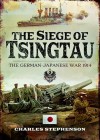The Siege of Tsingtau: The German-Japanese War 1914
Written by: Charles Stephenson
Pen & Sword, Barnsley, 2017,
ISBN: 9781526702920, 244pp
Reviewed by: Brigadier Chris Roberts AM, CSC (Rtd)
Charles Stephenson’s The Siege of Tsingtau: The German-Japanese War 1914 delivers far more than the title suggests. In a highly readable style, and covering a wide canvas, we are presented with a succinct history of Imperial Germany’s acquisition of territories in East Asia and the Pacific during the late 19th Century, her expulsion from the region in the opening months of the Great War, and Japan’s assumption as heir to Germany’s territorial possessions.
Rather than a narrow military history of a siege, this book provides an overview of an international power play in East Asia and the Pacific, Stephenson presents his narrative in an easily digestible style that runs smoothly through the main issues, with relevant digressions providing insights into moves behind the scenes. Interwoven throughout the story, Stephenson deftly highlights the international implications and machinations surrounding Germany’s quest for a presence in the area.
Underlying all this is the presumption by the major European powers, and the United States, of their right to acquire territory from other nations, either by force or intimidation. Desiring to join this quest for colonial acquisition is, of course, Japan, but lacking the means to do so until presented with the opportunity on the outbreak of war in 1914, through the instrument of her alliance with Great Britain.
Having covered Germany’s opportunistic acquisition of territory, including capitalising on the results of The Spanish-American War (1898), Stephenson addresses the implications of this on Britain, and her largest Dominion in the region - Australia - together with their reactions to this new found threat. For Britain, key to countering Germany’s growing naval presence was the Anglo-Japanese alliance and influencing the creation of the fledgling Royal Australian Navy in 1911. Both of these, Stephenson argues persuasively, compelled Admiral von Spee, with his East Asiatic Cruiser Squadron, to flee from the Pacific on the outbreak of war.
For Japan, the outbreak of war in Europe, and the British alliance provided the opportunity to strike and stake her claim on Germany’s possessions north of the equator, a position Britain readily acquiesced in. It is these events that Stephenson devotes most of his book to, culminating in the invasion of the Shantung Peninsula and the siege of Tsingtau itself, all of which is rounded off with a chapter on the consequences of Japans’s new found position for the future, and the failure of the United States and Britain to recognise the professionalism displayed by the Japanese Imperial Army and Navy.
Stephenson’s style is a pleasure to read, avoids getting into unnecessary and overwhelming details, and hits the main points to deliver a concise narrative, supplemented by analysis of the consequences of each event. While it may not suit the professional historian, it certainly provides the general reader with a worthwhile account of Germany’s dalliance in the region, followed by a little known naval and military campaign in the opening months of the Great War that was to have far reaching consequences well into the 20th Century.

